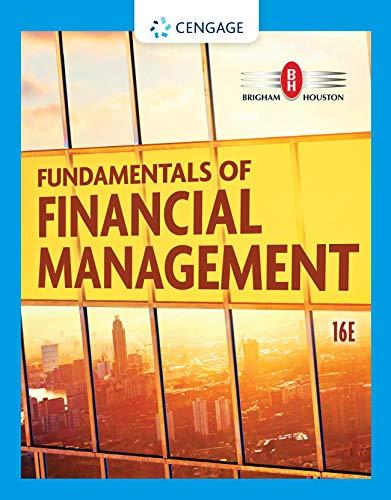Question
Create a company report and a financial model. The report should include your analysis and interpretation of the questions asked. Business writing should be used
Create a company report and a financial model. The report should include your analysis and interpretation of the questions asked. Business writing should be used for all reports. Reports should include bullet points, graphs, and charts where appropriate. Key assumptions and estimates should be explained but equations should never be discussed in the report.
The financial model should include all the financial analysis necessary to answer the questions and create your report. The financial model should look professional (formatting, labels, organized, etc) and all equations should be linked (see Creating a Financial Model under the getting started tab). Use the Excel examples posted on D2L as a guide for the models, but do not copy directly from them.
Company Report
- Each question is fully and correctly answered
- Excel solutions and explanation of estimation assumptions are included were applicable
- Very thoughtful and insightful
- Analysis and critical thinking evident
- Easy to find information (efficient use of headers, bullet points, graphs, etc)
- No fluff
- Clear and easy to follow logic
- No equations (efficiently refer to excel document)
- Wording, spelling, and grammar do not noticeably detract from the content
Financial Model
- Included all relevant equations and models required to answer the project problems
- Equations were used correctly
- Equations and models are created by the student (NOT copied from the class examples)
- The entire Excel document is formatted professional looking, and easy to read
- Excel document is setup like a financial model (i.e. all cells are linked)
Dividend Policy
Use dividend.com to find dividend information for your company. The information you will need can be found under the Dividend History and Upcoming Dividend Payouts tabs.
- Look at the historical dividend payments for the last 5 years. Look at the Dividend History tab.
- Does it appear that the firm uses a residual or sticky dividend policy?
- Does the firm appear to a high- or low-dividend payout policy?
- Explain what you think the firms reasoning for its current dividend policy is?
- Discuss how the current personal and corporate taxes might impact this decision.
- Discuss the information costs of the firms dividend policy.
- Discuss the impact the dividend policy has on the firms investment opportunity set.
- Find the firms next dividend payment on the Upcoming Dividend Payouts Tab. Based on this information does it look like the new dividend resulted in any abnormal returns? If so on what date would the abnormal returns occur?
- What impact would an SEO have on the firms dividend payments per share?
Note none of these questions require calculations but you are welcome to include them.
- Evaluate the following scenarios:
Scenario 1
- What is the total investor value (shares and cash) after the ex-dividend date? If an investor prefers capital gains to a dividend how many shares would the need to repurchase with their dividend payment? What is the total investor value (cash and shares) after they repurchase those shares? Compare the two values and explain why they are the same or different.
Assumptions:
- Investor owns 1000 shares
- Capital gains tax rate 15%
- Dividend tax rate 20%
- Find the firms next dividend payment on the Upcoming Dividend Payouts Tab.
- For simplicities sake assume the stock price will not change between now and right before the ex-dividend date
- Assume the market is efficient
Scenario 2
- If the company did not pay a dividend what is the total investor value (shares and cash) on the same date from Scenario 1(i.e. if the ex-dividend date was Dec 5th what is the investors value on Dec 5th if no dividend was paid)? If the investor preferred dividend payments to capital gains how many shares would the investor need to sell to synthesize the dividend payment from Scenario 1? What is the total investor value (cash and shares) after they sell those shares? Compare the total investor values from Scenario 1 and Scenario 2 and explain why they are the same or different.
- If the market was not efficient (i.e. the stock price did not decrease by the post-tax dividend price on the ex-dividend date) how would the total investor value be affected? (conceptual question).
Assumptions:
- Investor owns 1000 shares
- Capital gains tax rate 15%
- Dividend tax rate 20%
- Find the firms next dividend payment on the Upcoming Dividend Payouts Tab
- For simplicities sake assume the stock price will not change between now and right before the ex-dividend date
- Assume the market is efficient
Step by Step Solution
There are 3 Steps involved in it
Step: 1

Get Instant Access to Expert-Tailored Solutions
See step-by-step solutions with expert insights and AI powered tools for academic success
Step: 2

Step: 3

Ace Your Homework with AI
Get the answers you need in no time with our AI-driven, step-by-step assistance
Get Started


